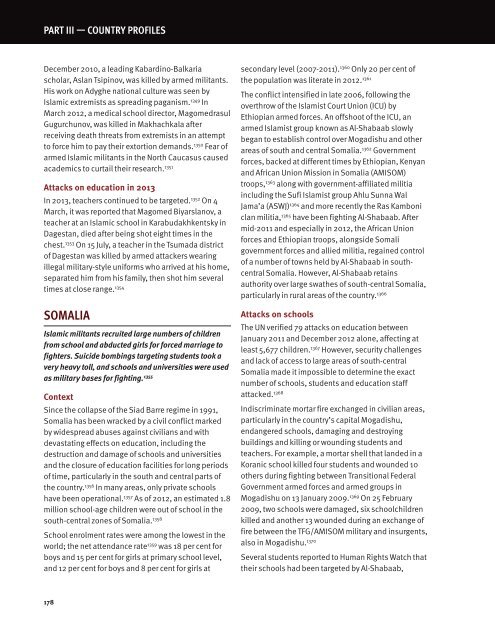You also want an ePaper? Increase the reach of your titles
YUMPU automatically turns print PDFs into web optimized ePapers that Google loves.
PART III — COUNTRY PROFILeS<br />
December 2010, a leading Kabardino-Balkaria<br />
scholar, Aslan Tsipinov, was killed by armed militants.<br />
His work on Adyghe national culture was seen by<br />
Islamic extremists as spreading paganism. 1349 In<br />
March 2012, a medical school director, Magomedrasul<br />
Gugurchunov, was killed in Makhachkala after<br />
receiving death threats from extremists in an attempt<br />
to force him to pay their extortion demands. 1350 Fear of<br />
armed Islamic militants in the North Caucasus caused<br />
academics to curtail their research. 1351<br />
Attacks on education in 2013<br />
In 2013, teachers continued to be targeted. 1352 On 4<br />
March, it was reported that Magomed Biyarslanov, a<br />
teacher at an Islamic school in Karabudakhkentsky in<br />
Dagestan, died after being shot eight times in the<br />
chest. 1353 On 15 July, a teacher in the Tsumada district<br />
of Dagestan was killed by armed attackers wearing<br />
illegal military-style uniforms who arrived at his home,<br />
separated him from his family, then shot him several<br />
times at close range. 1354<br />
SOMALIA<br />
Islamic militants recruited large numbers of children<br />
from school and abducted girls for forced marriage to<br />
fighters. Suicide bombings targeting students took a<br />
very heavy toll, and schools and universities were used<br />
as military bases for fighting. 1355<br />
Context<br />
Since the collapse of the Siad Barre regime in 1991,<br />
Somalia has been wracked by a civil conflict marked<br />
by widespread abuses against civilians and with<br />
devastating effects on education, including the<br />
destruction and damage of schools and universities<br />
and the closure of education facilities for long periods<br />
of time, particularly in the south and central parts of<br />
the country. 1356 In many areas, only private schools<br />
have been operational. 1357 As of 2012, an estimated 1.8<br />
million school-age children were out of school in the<br />
south-central zones of Somalia. 1358<br />
School enrolment rates were among the lowest in the<br />
world; the net attendance rate 1359 was 18 per cent for<br />
boys and 15 per cent for girls at primary school level,<br />
and 12 per cent for boys and 8 per cent for girls at<br />
secondary level (2007-2011). 1360 Only 20 per cent of<br />
the population was literate in 2012. 1361<br />
The conflict intensified in late 2006, following the<br />
overthrow of the Islamist Court Union (ICU) by<br />
Ethiopian armed forces. An offshoot of the ICU, an<br />
armed Islamist group known as Al-Shabaab slowly<br />
began to establish control over Mogadishu and other<br />
areas of south and central Somalia. 1362 Government<br />
forces, backed at different times by Ethiopian, Kenyan<br />
and African Union Mission in Somalia (AMISOM)<br />
troops, 1363 along with government-affiliated militia<br />
including the Sufi Islamist group Ahlu Sunna Wal<br />
Jama’a (ASWJ) 1364 and more recently the Ras Kamboni<br />
clan militia, 1365 have been fighting Al-Shabaab. After<br />
mid-2011 and especially in 2012, the African Union<br />
forces and Ethiopian troops, alongside Somali<br />
government forces and allied militia, regained control<br />
of a number of towns held by Al-Shabaab in southcentral<br />
Somalia. However, Al-Shabaab retains<br />
authority over large swathes of south-central Somalia,<br />
particularly in rural areas of the country. 1366<br />
Attacks on schools<br />
The UN verified 79 attacks on education between<br />
January 2011 and December 2012 alone, affecting at<br />
least 5,677 children. 1367 However, security challenges<br />
and lack of access to large areas of south-central<br />
Somalia made it impossible to determine the exact<br />
number of schools, students and education staff<br />
attacked. 1368<br />
Indiscriminate mortar fire exchanged in civilian areas,<br />
particularly in the country’s capital Mogadishu,<br />
endangered schools, damaging and destroying<br />
buildings and killing or wounding students and<br />
teachers. For example, a mortar shell that landed in a<br />
Koranic school killed four students and wounded 10<br />
others during fighting between Transitional Federal<br />
Government armed forces and armed groups in<br />
Mogadishu on 13 January 2009. 1369 On 25 February<br />
2009, two schools were damaged, six schoolchildren<br />
killed and another 13 wounded during an exchange of<br />
fire between the TFG/AMISOM military and insurgents,<br />
also in Mogadishu. 1370<br />
Several students reported to Human Rights Watch that<br />
their schools had been targeted by Al-Shabaab,<br />
178


